How To Use Watercolor Paint In Tubes
Disclosure: This post may contain chapter links. That ways if you buy something we may possibly become a modest committee at no extra cost to you.
Figuring out how to use watercolour tubes and pans is oft non the showtime hurdle for beginners… It'southward actually choosing what pigment you demand to brainstorm with!
Here are the answers to the questions I go asked near oft about how to become started with watercolour painting and everything a new painter needs to know well-nigh the kind of watercolour pigment that comes in tubes and pans.
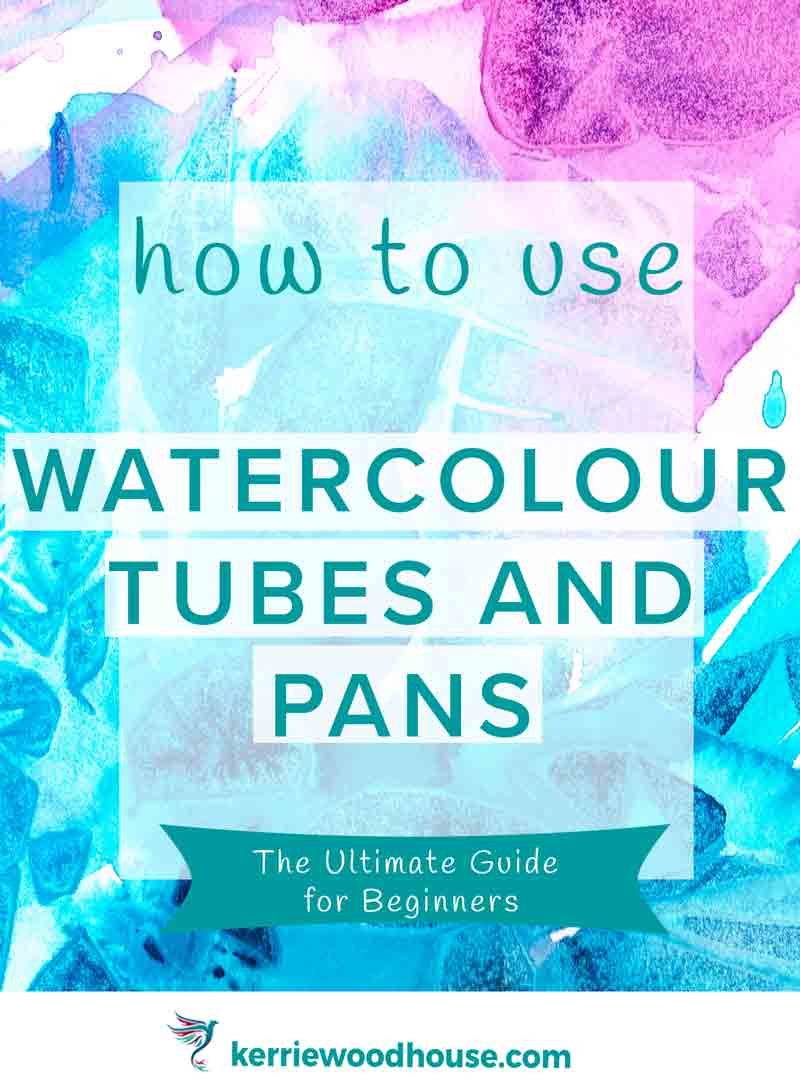
Which is ameliorate - watercolour tubes or watercolour pans?
If information technology is whatever consolation, I don't think you can make a incorrect choice between these 2 considering the watercolour pigment that comes in tubes and pans is very like.
Tube watercolour contains more glycerin to keep its flossy soft consistency, for as long equally it is sealed in the airtight tube. You tin buy tubes in sets or individually giving you all the option in the world when it comes to colours.
Pan watercolour is dry and hard and comes either in little individual white plastic containers (as well called pans) or stock-still into a palette box with a lid. If you buy a little fix of pan watercolours in a palette box with a lid all you lot need is a brush and you are skilful to go… anywhere. This grade of watercolor is very easily stored and transported.
With a fixed set yous are stuck with the colours in the box. However you can also purchase individual pans of watercolour (for the more than professional brands) which you can clip into a palette box.
Neither one is ameliorate or worse, I believe that is more to do with the quality of the pigment itself rather than its packaged form.
What type of watercolour paint should I choose?
Not only exercise you get to choose between watercolour tubes and pans, you also have to decide on brands and 'quality'. By quality I mean that most paints declare themselves to exist professional person/artist quality or pupil quality.
Well known brands such as Schmincke, and Winsor & Newton offer both. Some people swear by choosing merely the professional person quality but in my experience the student versions, especially from these big brands are perfectly fine. Usually the divergence is in the pigment ingredients with the more expensive paints containing college quality pigments. Student quality paints can contain cheaper pigments and/or more than folder.
At present price isn't always the best indicator of quality. It is possible to discover some paints that are inexpensive but even so delightful to use. I took a little set of Crayola paints (yes, for kids - don't laugh) on holiday because they were pocket-sized and like shooting fish in a barrel to throw into my bag. Those paints are joyful to use. Bright and happy and you don't have to worry most 'wasting practiced supplies' or other things that our inner critic tells us when we start learning to pigment.
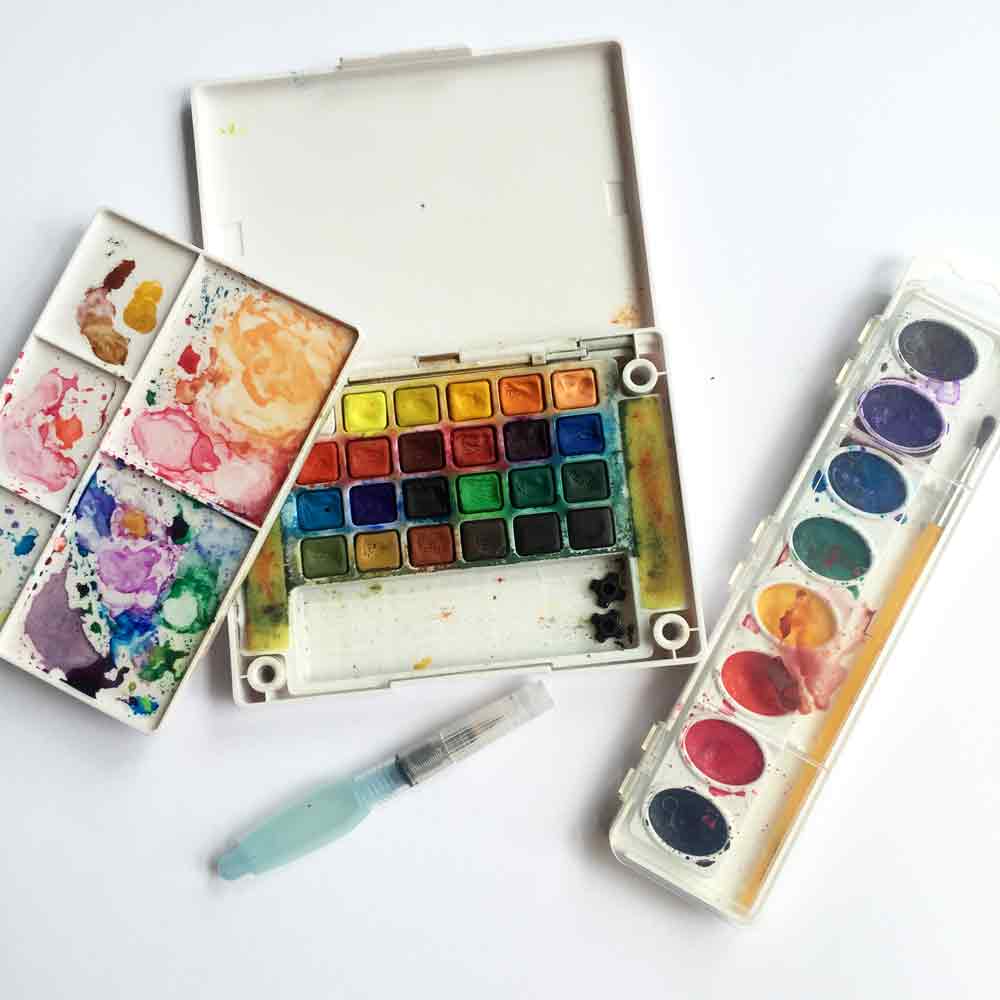
These are my no pressure level watercolour supplies. Cheap and cheerful pan sets that - as yous can see - get used a lot! My go-to favourite is my Sakura Koi travel set shown on the left, and the lilliputian Crayola set I mentioned is pictured on the right.
Having said that I tend to employ those watercolour sets and other less expensive sets like them in my watercolour sketchbooks rather than for a standalone painting, but they are a great fashion to kickoff.
My favourite in this category is my Sakura Koi travel set up. Information technology has lasted amazingly well and has and then many wonderful colours to choose from.
So to sum up here, the artist quality or professional paints are going to be reliable and easy to work with. If information technology is too much of a stretch still, I don't remember you will feel much of a divergence if y'all go for a pupil quality version such every bit the Cotman range from Winsor and Newton or the Schmincke Academie.
And don't turn your nose up at a nice starter palette box similar the Koi palette if you just desire to dip your toes in the water… or is that watercolour…. Come across what I did there ...
Why aren't all the colours in a watercolour paint line the same toll?
Ane the field of study of toll you will notice that in the big ranges of tubes and individual pans that not all the colours are the same cost. Typically they are in series, depending on the price of the pigments that are needed for each colour.
Some pigments are extracted from precious or semiprecious minerals and are expensive to extract. Oftentimes a manufacturer will figure out how to make a similar colour from synthetic pigments or a combination of cheaper pigments. You may find then that a colour that looks about the same is in two serial eg cobalt bluish and cobalt bluish hue. The one that is labelled 'hue' is probable cheaper as it contains the less expensive constructed pigments.
Engineering has come a long way - don't assume that the 'hue' is going to be dreadful, give it a go if you fancy the colour but non the price.
How many colours practise I need to start watercolour painting?
Honestly? One!
Monochrome paintings are a thing - a good affair and then really all y'all demand is one colour. You could get started with just i tube of watercolour pigment.
Don't believe me?
Here's a step by step tutorial showing you lot how to paint a swan with just one colour.
By increasing the amount of water y'all add to the paint y'all tin make lighter and lighter versions of the colour. By layering multiple layers of paint (letting each dry in between) y'all can make darken some areas of the painting because watercolour is transparent.
But 'demand' is a funny word. Equally in, how many pairs of shoes does a woman demand…
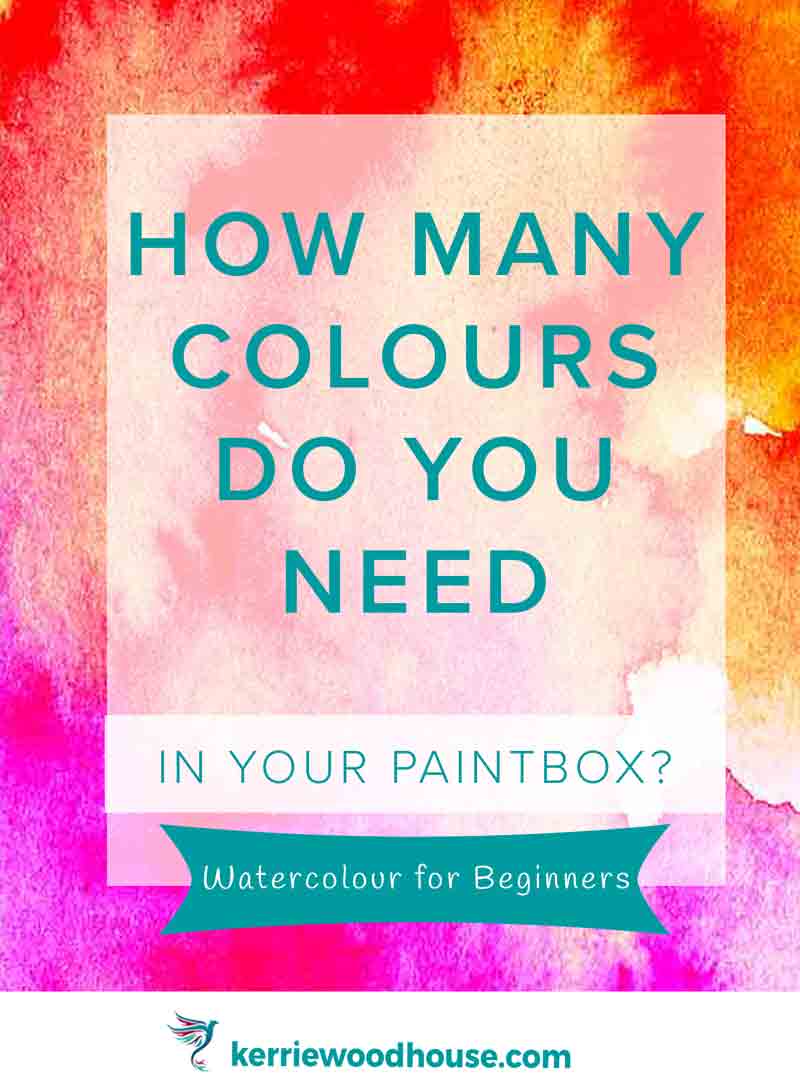
Yous could opt for iii master colours red, yellow and blueish and mix the others similar you learned in kindergarten.
Or the more modern accept on that - magenta, cyan and yellow like your printer. There is some other article all near that here.
If you know that you dear roses, for instance, and are going to be painting mostly them, you could choose the colours you lot might need for that, like pinks, yellows and greens perhaps.
If y'all opt for a set they sometimes come themed with colours y'all might use together. See the examples I found below of sets themed for marine and landscape paintings.
If y'all are prepared to go for more than than a few, so the next conventional wisdom is to get a warm (usually redder) and cool (usually bluer) tone of each of the primaries Eg an orangey red and a purpley cherry-red.
These days we are blest with and then many glorious color options that on this I tin't really help you.
Suffice to say you only need ane or maybe iii, simply you can bet on wanting a lot more than….
Do I need black and white watercolour pigment?
Watercolourists tend to avoid black and white - so these are non paints y'all commonly find in your sets.
Black watercolour paint
Black can be a scrap lifeless and deaden a painting. Instead watercolour painters usually opt to mix a nice interesting dark past combining colours. Mix all your primaries and run across what I mean.
If you go a standard watercolour set up with some of the more traditional colours you will unremarkably get an ultramarine blue and a burnt sienna. Together, these make a lovely dark (blackish) colour.
White watercolour paint
The white parts of a watercolour painting are already at that place - they are the paper. Your job is just to paint the parts that are non white!
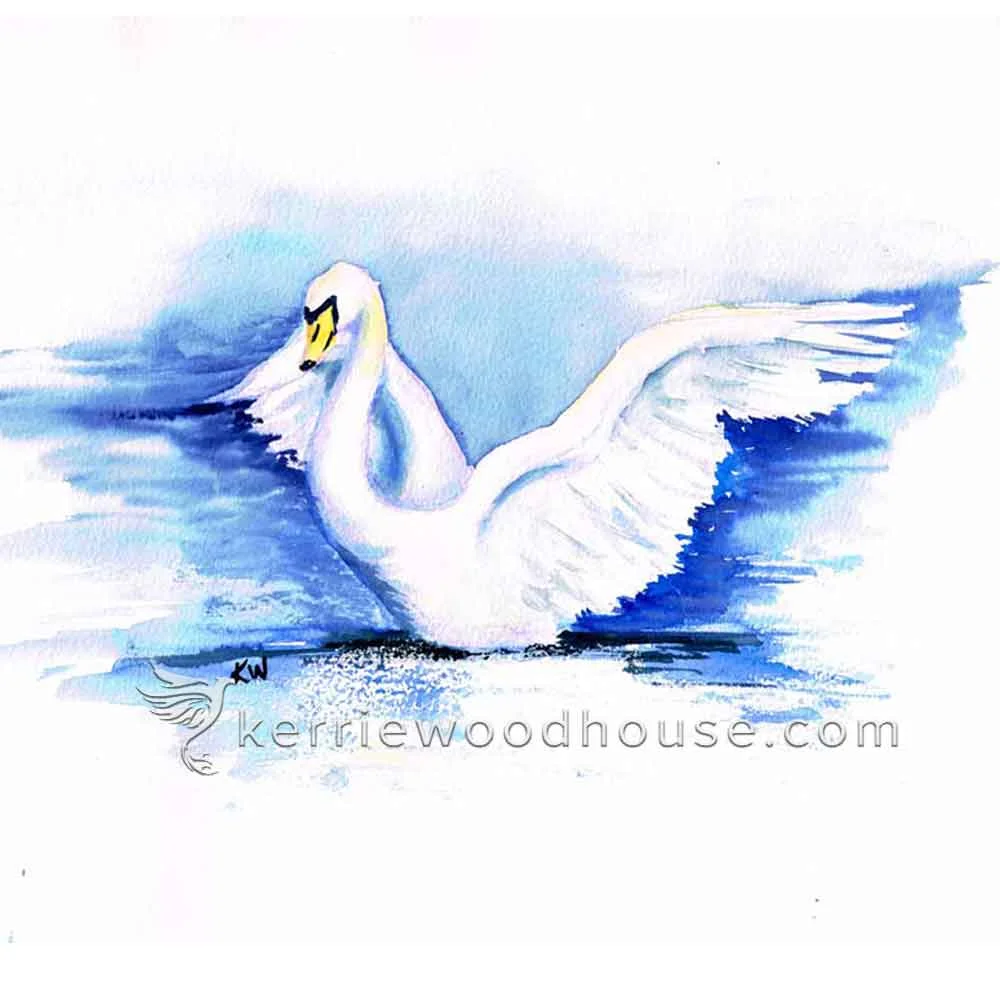
This white swan was painted in watercolour with no white paint at all. Click the image to a higher place to see more than dramatic birds painted in watercolour.
At schoolhouse you may accept mixed pale colours by adding white to vibrant colours but in watercolour you employ h2o to dilute them and let the white of the paper glow through the transparent colour to achieve the same effect.
Yes, this can be quite challenging.
Sometimes a painter might use white goauche (similar to watercolour paint but opaque) to add together whatsoever highlights dorsum in, merely a purist would never dream of information technology. You practice what y'all want to do. The rules are, there are no rules as far as I'chiliad concerned. There are other ways to paint white things in watercolour, but that'southward a story for some other commodity.
Tin I paint straight from the tube or pan?
Watercolour pans are dry out so you lot need to add some h2o to transform them from a hard cake into something yous can actually paint with. I find this is best washed with a little spritz of h2o from a spray bottle. You can get a trivial mister bottle from well-nigh craft stores or you tin repurpose something like an sometime hairspray bottle (not the aerosol kind obviously) as long as y'all rinse information technology out really, really well first.
I similar to spritz a lite mist of h2o over my whole paintbox and and then leave it for 30 seconds or and then to soften up a little. You could activate the dry pan by rubbing your wet brush into the colour y'all are going to use but I wouldn't propose this as it is hard on your poor paintbrush and quite tricky to control the amount of water yous are adding.

In theory, you lot can paint straight from the watercolour tube,, but yous would exist missing out. Water is the magic ingredient! Whether you lot use tubes or pans, you volition need to dilute the paint to get the about out of it. Information technology is only in the presence of h2o that the watercolour paint tin practise its magical tricks.
If you are using watercolour tubes you will need to begin by squeezing out a little paint onto a palette. So y'all tin add a scrap of water to the paint on the palette using your brush to get the consistency you are looking for.
Concentrated watercolour paint behaves differently from dilute watercolour paint. The almost important affair to learn when you start watercolor painting is an agreement of how the ratio of paint pigment to water will alter the results of your painting.
And so either way yous will need a palette for your watercolour painting. Which raises the next question….
What kind of palette do I need to paint with watercolour tubes and pans?
If you cull a pan set it volition most likely come with some sort of palette built into the box. If you don't run across an obvious palette (ie plastic or metal tray with sections) then use the hat.
The sections tin can be helpful in keeping your paint colours separate. This is important because if you have something similar a red and a green on your palette and they end up mixing together you will end upwardly with a disappointing muddy chocolate-brown grey. (Actually this is non always disappointing, but for now let's merely stay on track.)
If you don't accept sections, never fearfulness! Yous can keep the puddles of colour distinct by spacing them far enough autonomously on your palette. If you ever run out of room you can always clear a space by spraying a section you aren't using anymore with water and wiping it clean with a newspaper towel or sometime rag. This is a tremendous advantage of watercolour I recollect - easy instant make clean upwardly!
You tin can also use a separate palette. You can buy a plastic or ceramic palette in the art shop, simply you don't need to. An old plain ceramic plate or a dispensable plastic plate will work just as well. And you lot can buy pads of palette newspaper that are handy too.
Ceramic palettes are smooth and clean to work from but have no lid for easy storage at the terminate of your painting session.
Large lidded palettes have lots of mixing surface area and are piece of cake to close up when you are finished painting. The downside is storing the big apartment surface area that this mode of palette takes up.
Palette newspaper is handy to take every bit you can only tear off the sheet when you are done painting and throw it away. I find this is more useful for acrylics and oils as watercolour is very easy to clean upwards.
I have likewise used acetate sheets - the kind we used to use for overhead projectors… gosh, remember those…
If you cull watercolour tubes then of class all of the to a higher place suggestions for split up palettes employ. Simply I practise accept another suggestion for y'all which I consider to exist the best of both worlds when it comes to tubes and pans…
Best of both worlds - create a custom watercolour palette
For me, the all-time of both worlds is to create a custom palette box. When I decided to get some good quality professional watercolours I opted for a set of Schmincke pans in a metal palette box tin. It was a bit of an investment merely I have never looked dorsum. It is one of those tins that comprise metal rods that hold the little white plastic pans. My set came with 24 colours, I think, but I chose it in the 48 size tin. To commencement with I had many colours to cull from, but I also have the selection of calculation more as time goes on.
You tin can observe metal tins that are completely filled with pans or some with empty spaces allowing you to expand your palette when y'all are set.
Y'all tin can buy empty white pans and fill up them with paint, or y'all can buy the little pans with the watercolor pigment already inside. This ways your paint choice tin grow with you. Yous tin can also rearrange the order of the paints by shuffling the fiddling pans effectually. And so many options….
I tend to refill my used pans with tube watercolours rather than buying the little filled pans over again because it is a fair chip cheaper. I tin refill a pan many times from ane tube of paint. I also tend to mix information technology up and try different brands of pigment. I really can't recollect of a paint supply that gives you so many options in such a compact style.
You can't beat watercolour when if comes to no mess no fuss painting.
Merely what if you are starting out and are not ready to make the investment?
You tin have the same sort of arrangement without shelling out for the fancy metal tin with adjustable pans. There are many keen paint boxes available. They are unremarkably plastic and come with a lid and or the extra palette tray/mixing infinite. The but downside is that the picayune wells for the paint are stock-still which means you won't be able to move them effectually, only honestly that is no big bargain.
There are many plastic palettes like these bachelor. Look for a overnice sturdy box with a lid and you can't really become incorrect. The trivial wells are fixed and so you lot can't move the colours around easily just that'south not too much of an effect in my opinion.
I would suggest choosing a couple of tube colours and filling upwardly a well in the plastic box with each one. The paint volition dry out into a cake format over a twenty-four hours or more, depending on the brand. And then you tin spritz information technology with water then side by side time you are prepare to paint and it will bound dorsum to life. You can add new colours to your palette as and when you need them.
How to showtime painting with watercolour
Ok. Nosotros have a palette and some watercolour pigment. What at present?
Well you do need a nice soft brush (not a bristly, inflexible ane - those are for oils) and some paper. The paper is very of import - you practise demand to have newspaper that can cope with the water. I recommend 300gsm cold pressed watercolour newspaper. This article volition tell you all you need to know about newspaper.
If you have never painted before so I advise you have a become at just playing with the paint and getting used to how it behaves on the newspaper. Aim for a nice messy colourful folio - what fun!
We have already established that you need water to see watercolour pigment at its best. To paint annihilation you need to beginning with wet pigment. In that location are two main watercolour techniques to have a go at:
-
Moisture on dry
Endeavor applying some wet paint onto dry newspaper - that'due south what the name of this technique is referring to. Watercolour pigment moves in h2o. So if you apply information technology to dry paper it will only go where you put it. If you want more control over your watercolour paint, this technique will help with that.
Play and experiment with this wet on dry technique:
-
Pigment with concentrated, undiluted paint
-
Pigment with very very dilute paint - much paler, isn't it?
-
Paint with Goldilocks mode merely correct paint… it will take some experimentation to discover where this is for y'all
-
Employ your brush in unlike ways to see how many dissimilar marks yous can brand with one brush, eg
-
hold it perpendicular and paint with only the tip making a fine marker,
-
squash the castor flat to the folio and paint with the 'belly' making a big juicy broad mark
-
Alternate the pressure to encounter if you lot can make a fat marking that tapers to thin and vice versa
-
Drag the castor over the paper to see if you can make a different marking
-
Dab the castor repeatedly to see if you can make a sort of stippled amorous effect
-
Whatsoever other mark making variation you can think of
ii. Wet on moisture
-
This is my favourite technique. Instead of starting with dry newspaper, take a clean brush and dip information technology into your water. Paint a piffling puddle of make clean h2o on your dry folio. Now you lot tin cull a colour to put your brush into. Touch the paint to the moisture page and watch it spread - isn't that glorious?

Play and experiment with this wet on wet technique:
-
Try a very moisture clean pool on the page and drop in a flake of colour
-
Make a clean puddle but look a bit so that the h2o soaks into the page before you add together the colour - compare your results with the beginning one and endeavour different lengths of drying time
-
Effort more than than 1 colour on your wet (more like damp) pool and watch them alloy
-
Paint some of the marks you lot learned to brand in the moisture on dry section on clammy newspaper and compare the difference - see how you lose the distinct edges?
-
Paint a puddle of colour onto the folio and so drop in another color. This is nevertheless wet on moisture, information technology'due south just wet colour instead of wet clean paper
-
Try dropping clean water into a puddle of damp colour and wait to see the furnishings it makes. Don't push the water about - merely allow the paint and water practice its own thing to see what happens.
-
And then exercise information technology once again but do push button the water almost - compare the unlike effects.
So much fun, right? Simply I bet yous want to paint an bodily thing now, don't yous? Practiced for y'all - go right ahead!
If you would like a trivial more aid with that I have a whole class for beginners well-nigh collaborating with the paint. Want to see?

What do I do with leftover watercolour paint in my palette?
1 of the very useful properties of water is that it reactivates with water. And then any leftover paint on your palette tin be used in your adjacent painting session simply by rewetting it.
My palette is ofttimes a huge mess merely I like it that way. I feel like I am just picking upwards where I left off rather than starting something make new. I observe that makes it easier to get back into the swing of things.
Likewise, I have a problem with waste. Cleaning off the palette at the end of the session is easy and of course if you like things that way of course you could do that. (Remember, all y'all need to do is wipe it make clean with a damp cloth or paper towel.)
I find that if I know I tin can use all of the paint in the mixing wells of my palette in another painting, fifty-fifty on another 24-hour interval, and then I can be more bold with the colour in this painting.
And that is what I like, assuming, liberated painting - how about you?
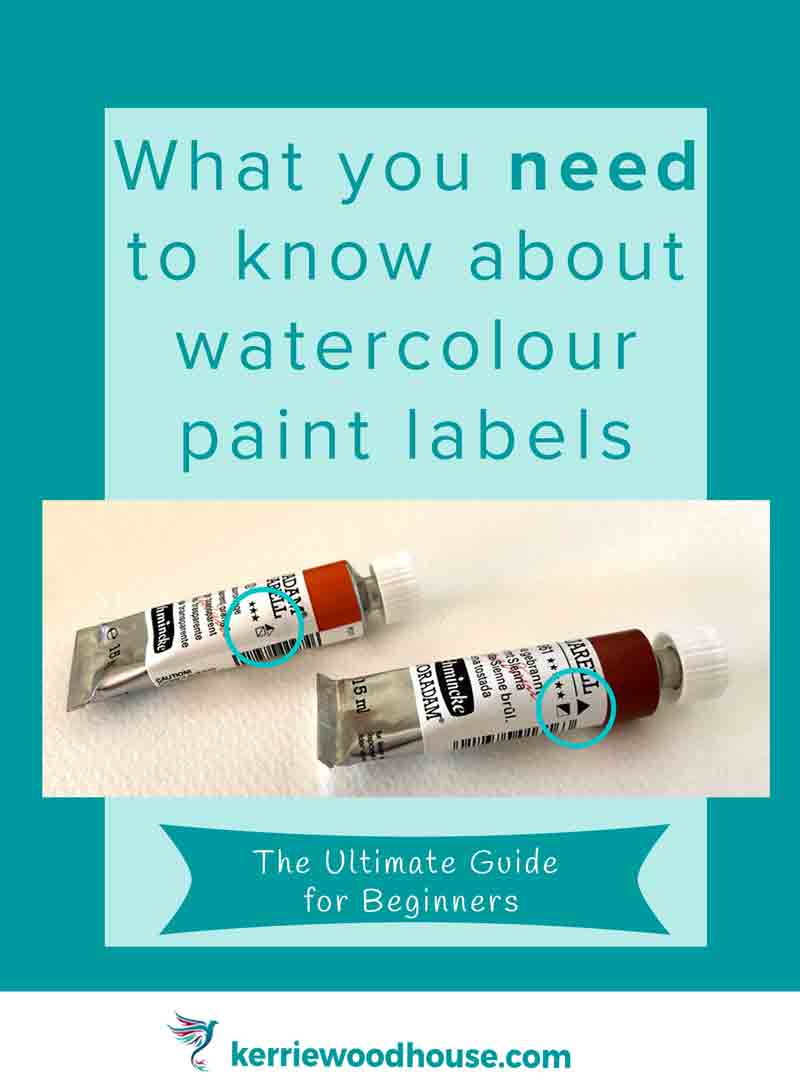
What characteristics of watercolor paint practise I need to know about?
You lot will probably notice a lot of little symbols on the labels of watercolour paint tubes and pans. These give you information virtually the important characteristics of each colour. Different brands use different symbols merely they are usually circles and triangles and squares that are empty, completely filled in or one-half filled in.
These are the properties and characteristics that they represent.
Transparency
Ane of my favourite properties of watercolour paint is transparency. The bright colours are laid like a sheer veil over the paper letting the white of the newspaper glows through. Paints can be layered in the aforementioned or different colours and when they are transparent you will run into the underneath layer through the pinnacle layer. That means you lot can achieve colour mixing without actually mixing the paint.
Just not all watercolour pigment is transparent. Some are merely semi transparent and some are opaque. I take 1 or ii opaque or semi transparent colours simply I favour the transparent ones. If y'all observe that you adopt the opaques you might desire to await into some gouache which is like opaque watercolour. But watercolour is the best… obvs…
Granulating
Some paint pigments blend smoothly and evenly in the water giving you a uniform colour. Others do non play quite as well with the h2o and separate from the binder when diluted. The paint grains then settle into the ridges of the paper leaving a grainy texture.
This can leave you with some actually interesting variation in your painting - if that's your thing. If not, stick to pigments that are described as non-granulating.
Staining
While watercolour paint is wet you can 'elevator' it out. This means that either with a make clean brush or a rag or paper towel you can blot the damp paint and information technology will come clean off the paper. Only that is, if it is a non-staining colour.
A staining colour does what it says on the bundle and will leave a hint of itself on the paper. You could elevator information technology out on purpose knowing that it will leave a subtle version of itself at that place on the newspaper. Merely if yous are trying to lift it out because you changed your listen and then this will only be possible with the non-staining pigments.
At that place are a few colours with very persistent pigments. My art table is white (okay formerly white). Information technology is now spattered with some very vibrant pink splashes which no amount of household bleach will remove. Schmincke Brilliant Pink…. If y'all are wondering….
Archival, lightfast and fugitive
Yous volition often hear of art supplies as being described as archival. This ways that they are likely to stand up the test of fourth dimension and will non deteriorate. If you are a beginner, and so I don't think this is a master concern and may non be worth the higher price tag for the paints when yous are just learning. Student quality paints are less likely to exist archival.
Similarly, some fine art materials are described as lite fast, or non lightfast. This is describing the likelihood of deterioration of the pigment when subjected to low-cal. A good example is Opera Rose by Daniel Smith. Near everyone adores this color, but some endeavor not to use information technology because it is not lightfast. Some other give-and-take for colours like this is avoiding.
Fugitive colours are to exist considered temporary. They may change over time, meaning that if you lot use them in your masterpiece it may not wait the same in the years ahead. When you are starting out I don't recollect y'all should worry overly about this sort of affair, merely I would hate to leave out a piece of information that you may need.
Colours with names like 'permanent' and 'new' and paints with a loftier lightfast rating (these are usually in Roman Numerals so you lot are looking for I or II) are your safest options if this is a business organisation to you, as is sticking with the professional or creative person quality paints.
If you go to the manufacturers website you will be able to find a colour chart with a primal to all the symbols they use. This one is an extract from the Schmincke chart.
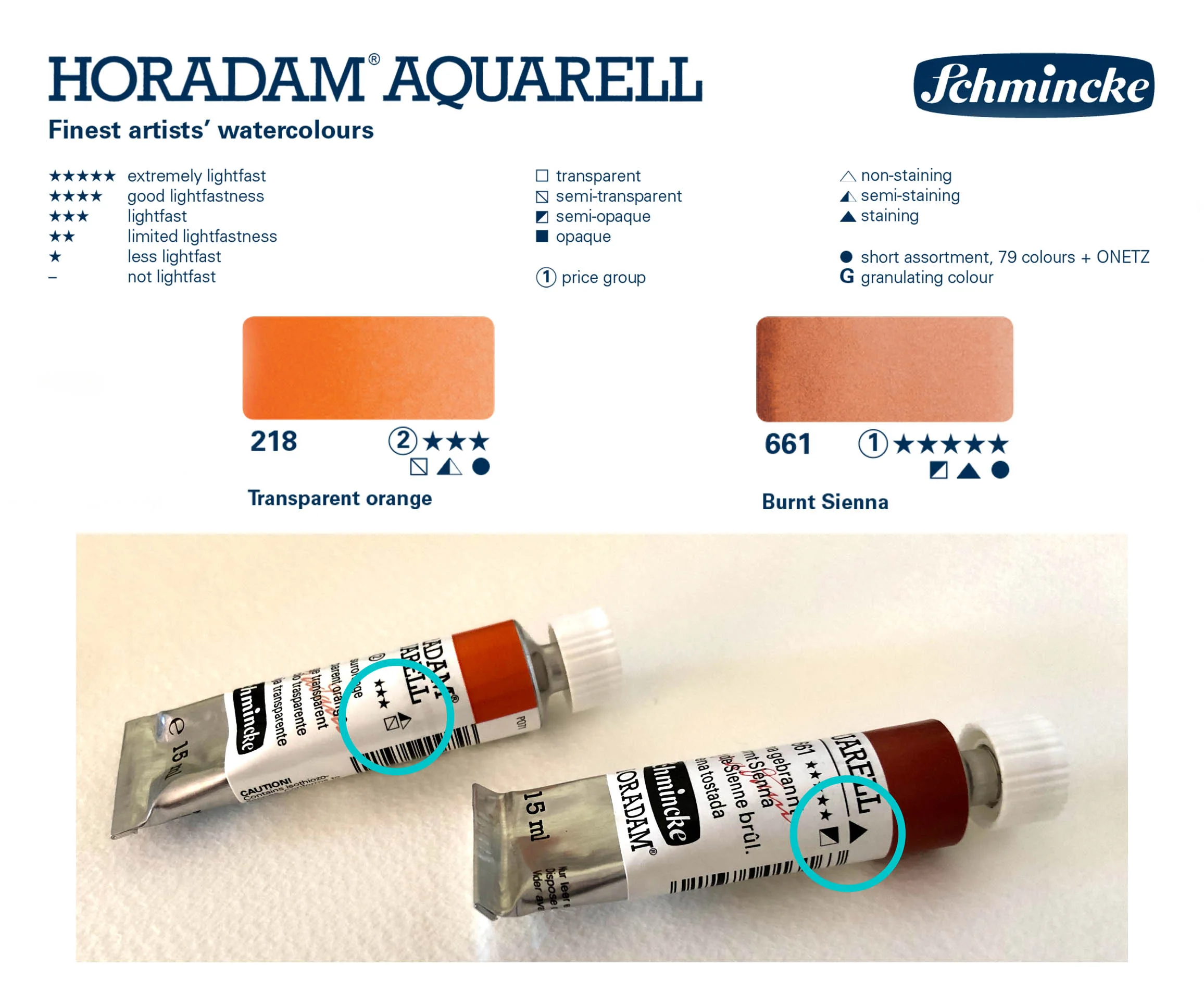
Then at that place yous have it - all you need to know about how to paint with watercolour tubes and pans. Watercolour is available in other forms likewise, these days. This link volition take you to some other article all about the different types of watercolour that you might want to endeavor.
Desire a costless course on beginner watercolour supplies?
I've got you covered…

If y'all would like some help with your first painting project, 1 of these might just be for you.
Go on on reading….
Source: https://www.kerriewoodhouse.com/blog/how-to-use-watercolour-tubes-pans
Posted by: ruedastakinguinks.blogspot.com




0 Response to "How To Use Watercolor Paint In Tubes"
Post a Comment